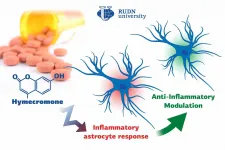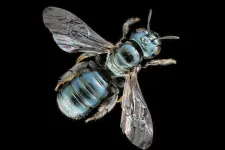Study finds link between racial, socioeconomic factors and atrial fibrillation treatment
Findings show Black, Latinx, and lower income patients receive less rhythm control
2021-02-26
(Press-News.org) PHILADELPHIA-- Even though the use of rhythm control strategies for treating Paroxysmal Atrial Fibrillation (AF), a common abnormal heart rhythm, have increased overall in the United States, patients from racial and ethnic minority groups and those with lower income were less likely to receive rhythm control treatment - often the preferred treatment - according to new research from the Perelman School of Medicine at the University of Pennsylvania. The study is published in the JAMA Network Open.
"Research has demonstrated the pervasive impact of structural racism on health outcomes among minoritized patients. We know, for instance, that there is less use of novel cardiovascular therapies among Black, Latinx, and patients of lower socioeconomic status," said the study's lead author, Lauren Eberly, MD, MPH, a cardiology fellow at the University of Pennsylvania. "That's why we wanted to evaluate the rates of antiarrhythmic drugs and catheter ablation and investigate for the presence of inequities to see how we can do better from an equity standpoint."
Atrial Fibrillation is the most common sustained heart rhythm disorder, and is the cause of significant complications including heart failure and stroke, which can be deadly for some patients. The two forms of rhythm control are antiarrhythmic drugs and catheter ablation, which aims to eliminate the sources of atrial fibrillation. Evidence suggests that when doctors pursue these rhythm control strategies early in the course of the patient's disease, they are more likely to successfully control the condition, and long term cardiovascular outcomes are improved.
Researchers examined data from October 2015 to June 2019 from more than 100,000 diverse, commercially insured patients, and found that from 2016 to 2019 the cumulative percentage of patients treated with antiarrhythmic drugs and catheter ablation increased from 1.6 percent to 3.8 percent. Despite this overall increase, patients with Latinx ethnicity and those who lived in zip codes with lower median household incomes were less likely to receive catheter ablation treatment, and Black and lower-incomes patients were less likely to be prescribed antiarrhythmic drugs or treated with catheter ablation.
Overall, patients living in areas with median household incomes of less than $50,000 were 39 percent less likely to receive catheter ablation compared with those with a median household income of $100,000 or more.
According to researchers, the number of cardiology visits by each patient was one of the strongest factors associated with rhythm control and catheter ablation use, stressing the importance of access to care. The findings suggest that reduced access to specialty care, including cardiovascular care for Black patients, is a potential reason for differences in treatments.
"As evidence builds regarding the benefits of early rhythm control and particularly catheter ablation, we must ensure that all our patients benefit equally" said the study's senior author, David Frankel, MD, Associate Professor of Medicine and Director of the Cardiac Electrophysiology Fellowship.
Eberly also hopes that in addition this awareness will push primary care providers and non-cardiac providers to more readily consider rhythm-control strategies or referral to a specialist, particularly for those patients who have been historically marginalized by the healthcare system.
INFORMATION:
Funding was provided by the Mark Marchlinski Research and Education Fund.
Penn Medicine is one of the world's leading academic medical centers, dedicated to the related missions of medical education, biomedical research, and excellence in patient care. Penn Medicine consists of the Raymond and Ruth Perelman School of Medicine at the University of Pennsylvania (founded in 1765 as the nation's first medical school) and the University of Pennsylvania Health System, which together form a $8.6 billion enterprise.
The Perelman School of Medicine has been ranked among the top medical schools in the United States for more than 20 years, according to U.S. News & World Report's survey of research-oriented medical schools. The School is consistently among the nation's top recipients of funding from the National Institutes of Health, with $494 million awarded in the 2019 fiscal year.
The University of Pennsylvania Health System's patient care facilities include: the Hospital of the University of Pennsylvania and Penn Presbyterian Medical Center--which are recognized as one of the nation's top "Honor Roll" hospitals by U.S. News & World Report--Chester County Hospital; Lancaster General Health; Penn Medicine Princeton Health; and Pennsylvania Hospital, the nation's first hospital, founded in 1751. Additional facilities and enterprises include Good Shepherd Penn Partners, Penn Medicine at Home, Lancaster Behavioral Health Hospital, and Princeton House Behavioral Health, among others.
Penn Medicine is powered by a talented and dedicated workforce of more than 43,900 people. The organization also has alliances with top community health systems across both Southeastern Pennsylvania and Southern New Jersey, creating more options for patients no matter where they live.
Penn Medicine is committed to improving lives and health through a variety of community-based programs and activities. In fiscal year 2019, Penn Medicine provided more than $583 million to benefit our community.
ELSE PRESS RELEASES FROM THIS DATE:
2021-02-26
A Mason Engineering researcher has discovered that artificial microswimmers accumulate where their speed is minimized, an idea that could have implications for improving the efficacy of targeted cancer therapy.
Jeff Moran, an assistant professor of mechanical engineering in the Volgenau School of Engineering, and colleagues from the University of Washington in Seattle studied self-propelled half-platinum/half-gold rods that "swim" in water using hydrogen peroxide as a fuel. The more peroxide there is, the faster the swimming; without peroxide in pure water, the rods don't swim.
In this work, they set out to understand ...
2021-02-26
People living with obesity tend to have unhealthy glucose and lipid levels in their blood, as well as high blood pressure. As a result, they are more at risk of cardiovascular and metabolic diseases. But scientists have observed that up to 45% of people living with obesity have healthy blood pressure and glucose and lipid levels, and therefore may not be at high risk of disease. The reason why this group of people with obesity remain healthy, has been poorly understood.
But now a team of researchers - led by scientists at the University of Copenhagen and Icahn School of Medicine ...
2021-02-26
Biologists from RUDN University confirmed that a well-known spasmolytic drug called hymecromone can suppress the inflammatory response in astrocytes, important glial cells of the central nervous system. Potentially, it could be used to develop medications against Alzheimer's disease and other neurodegenerative conditions. The results of the study were published in the International Journal of Molecular Sciences.
All pathological processes in the nervous system, such as neurodegenerative diseases, injuries, or intoxications, are associated with inflammations. ...
2021-02-26
An insecticide used to control pest infestations on squash and pumpkins significantly hinders the reproduction of ground-nesting bees -- valuable pollinators for many food crops, a new University of Guelph study has revealed.
This first-ever study of pesticide impacts on a ground-nesting bee in a real-world context found female hoary squash bees exposed to imidacloprid dug 85 per cent fewer nests, collected less pollen from crop flowers and produced 89 per cent fewer offspring than unexposed bees.
"Because they're not making nests and not collecting pollen, they cannot raise offspring," said Dr. Susan Willis Chan, a post-doc in the School of ...
2021-02-26
Heart problems cause disturbed gene activity in the brain's memory center, from which cognitive deficits arise. Researchers at the German Center for Neurodegenerative Diseases (DZNE), the University Medical Center Göttingen (UMG) and the German Center for Cardiovascular Research (DZHK) come to this conclusion based on laboratory studies. They consider that they have found a possible cause for the increased risk of dementia in people with heart problems. In mice, a specific drug which is known to affect gene activity alleviated the mental deficits. The involved experts see these results as potential approaches for therapies. ...
2021-02-26
HOUSTON - (Feb. 26, 2021) - Tracking the origin of synthetic genetic code has never been simple, but it can be done through bioinformatic or, increasingly, deep learning computational approaches.
Though the latter gets the lion's share of attention, new research by computer scientist Todd Treangen of Rice University's Brown School of Engineering is focused on whether sequence alignment and pan-genome-based methods can outperform recent deep learning approaches in this area.
"This is, in a sense, against the grain given that deep learning approaches have recently outperformed traditional approaches, such as BLAST," he said. "My goal with this study is to start a conversation about how to combine the expertise of both domains to achieve further improvements for this important computational ...
2021-02-26
TORONTO, Feb. 26, 2021 - The maternal care of offspring is one of the behavioural drivers that has led some bee species to have an ever-expanding social life over the history of evolution, new research out of York University has found.
By virtue of being in a social group, the genome itself may respond by selecting more social rather than non-social genes. The behaviour and social environment come first, setting the stage for future molecular evolution.
In addition, the researchers have found that a similar genetic evolution happened independently in different species at different times, suggesting there is a unifying principle leading to the same social trait.
"There seems to be something about sociality specifically that is driving the genome to evolve in this way. It's a very ...
2021-02-26
COLUMBIA, Mo. -- Marilyn Rantz still remembers the day she got the call that her mother, whose health had been declining, had fallen and fractured her shoulder. After rushing to the hospital, her mother told her she didn't understand how she ended up on a helicopter pad after the traumatic incident. A nearby nurse told Rantz the noise from the MRI scanning tube had caused her frightened mother to mistakenly believe she had been airlifted to the hospital on a helicopter.
Determined to prevent avoidable hospitalizations, as well as the stress and panic that often comes along with the ambulance ride, Rantz, ...
2021-02-26
MEMPHIS, Tenn. - Extremely low birth weight (ELBW) infants with moderate to large patent ductus arteriosus (PDA) may benefit from transcatheter PDA closure (TCPC) in the first four weeks of life, according to research published by Le Bonheur Cardiologist Ranjit Philip, MD, and Medical Director of Interventional Cardiac Imaging and Interventional Catheterization Laboratory Shyam Sathanandam, MD. Early PDA closure may prevent early onset pulmonary vascular disease, promote growth and facilitate faster weaning off supplemental oxygen and ventilator support.
"The primary objective of this study was to describe changes in hemodynamics, ...
2021-02-26
The National Cancer Institute's Genomic Data Commons (GDC), launched in 2016 by then-Vice President Joseph Biden and hosted at the University of Chicago, has become one of the largest and most widely used resources in cancer genomics, with more than 3.3 petabytes of data from more than 65 projects and over 84,000 anonymized patient cases, serving more than 50,000 unique users each month.
In new papers published Feb. 22 in Nature Communications and Nature Genetics, the UChicago-based research team shares new details about the GDC, which is funded by the National Cancer Institute (NCI), via subcontract with the Frederick National Laboratory for Cancer Research, currently operated by ...
LAST 30 PRESS RELEASES:
[Press-News.org] Study finds link between racial, socioeconomic factors and atrial fibrillation treatment
Findings show Black, Latinx, and lower income patients receive less rhythm control





